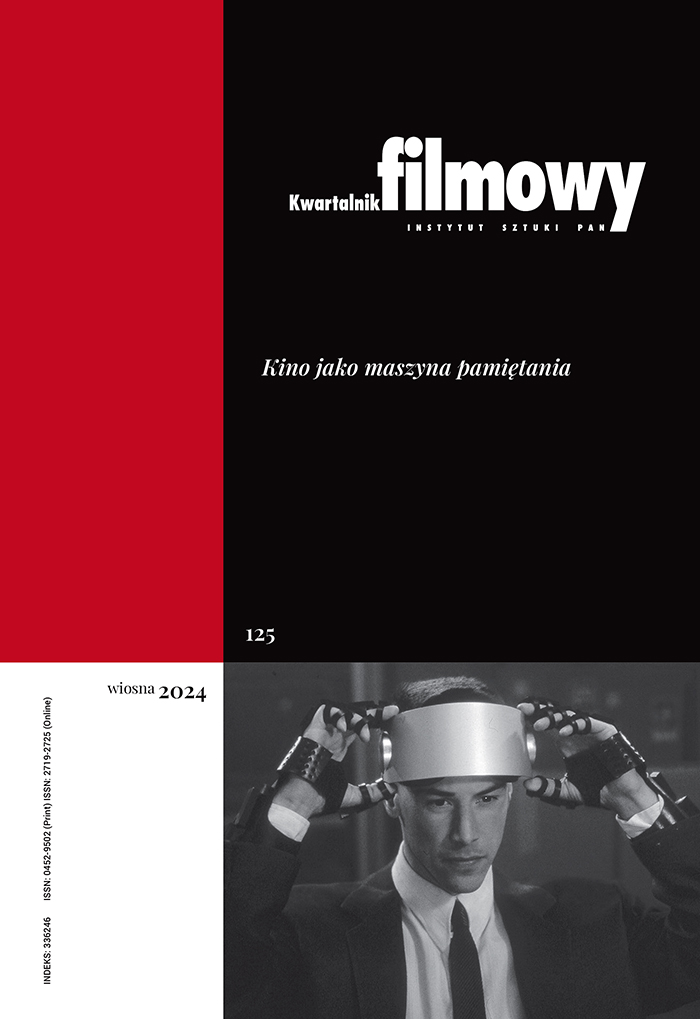Loneliness on Screen: The Screen Life of Paintings by Edward Hopper
Abstract
The work of Edward Hopper is a perfect example of the relationship between painting and film. On the one hand, the painter borrowed film images in order to create a painting similar to a frame of a film. Echoes of Hopper's style can be found in films where local architecture, customs and people of America of old are presented. It is also present in road movies, in its' scenery and message. In the article three films are presented and analysed: Sam Mendes' Road to Perdition, Peter Bogdanovich's The Last Picture Show, and Clint Eastwood's The Bridges of Madison County. Those films enter a dialogue with Hopper's paintings, although not necessarily in a self conscious way. The films contain themes typical of Hopper's work: empty landscapes, deserted towns and still, lonely people with expressionless faces. Apart from similarities in the iconography, what matters is the similarity in themes of alienation, emptiness and meaningless of life in small town America as well as in big cities.
Keywords:
Edward Hopper, painting, loneliness, void, cityReferences
Altman Charles F., W stronę teorii gatunku filmowego, tłum. A. Helman, „Kino” 1987, nr 6, s. 18-22.
Google Scholar
Bellow Saul, Stan zawieszenia, tłum. T. Lechowska, PIW, Warszawa 1984, s. 121.
Google Scholar
Brion Patrik, Kino amerykańskie jako kino przygody, „Kultura Filmowa” 1968, nr 5, s. 39.
Google Scholar
Ciapara Elżbieta, Amerykańskie sny Wima Wendersa, „Film” 2005, nr 10, s. 68.
Google Scholar
Giżycki Marcin, Ameryka Wima Wendersa, „Kwartalnik Filmowy” 2005, nr 49-50, s. 199, 201.
Google Scholar
Goodrich Lloyd, Edward Hopper, Harry N. Abrams, New York 1976, s. 64, 70, 89, 122.
Google Scholar
Helman Alicja, Mit, w: Słownik pojęć filmowych, t. 8, red. A. Helman, Wiedza o Kulturze, Wrocław 1998, s. 40.
Google Scholar
Helman Alicja, Styl, w: Słownik pojęć filmowych, t. 4, red. A. Helman, Wiedza o Kulturze, Wrocław 1993, s. 131.
Google Scholar
Hunter Sam, Modern American Painting and Sculpture, Dell Publishing Company, New York 1963, s. 115.
Google Scholar
Janson Horst Woldemar, Historia sztuki od czasów najdawniejszych po dzień dzisiejszy, „Alfa” – Philip Wilson Warsaw, Warszawa 1993, s. 675.
Google Scholar
Kornatowska Maria, Edward Hopper i kondycja amerykańska, „Kino” 1997, nr 10, s. 30.
Google Scholar
Levin Gail, Hopper’s Places, University of California Press, Berkeley – Los Angeles – London 1998, s. 6, 8.
Google Scholar
Lubelski Tadeusz, Miłość pięćdziesięciolatków, „Kino” 1996, nr 3, s. 28.
Google Scholar
Mitry Jean, Ekspresjonizm i jego wpływ na kino dzisiejsze, tłum. D. Knysz-Rudzka, „Kultura Filmowa” 1972, nr 2, s. 35.
Google Scholar
Osęka Andrzej, Hitchcock obrazu, „Wprost” 2004, nr 23 (1123), http://www.wprost.pl/ar/60922/Hitchcock-obrazu/ [dostęp: 1.06.2004].
Google Scholar
Piaseczyński Piotr, Słoneczne światło na ścianie domu, „Odra” 1998, nr 5, s. 56.
Google Scholar
Płażewski Jerzy, Język filmu, Wydawnictwa Artystyczne i Filmowe, Warszawa 1982, s. 64-65.
Google Scholar
Przylipiak Mirosław, O gatunkach filmowych, w: Od fantastyki do komiksu. W kręgu gatunków filmowych, red. K. Sobotka, Łódzki Dom Kultury, Łódź 1993, s. 25-26.
Google Scholar
Renner Rolf Günter, Edward Hopper. 1882-1967. Przetwarzanie rzeczywistości, tłum. E. Tomczyk Taschen – TMC Art, Kolonia – Warszawa 2002, s. 58.
Google Scholar
Shepard Sam, Wielki sen o niebie, tłum. C. Murawski, PIW, Warszawa 2004, s. 102-103.
Google Scholar
Stachówna Grażyna, Niedole miłowania. Ideologia i perswazja w melodramatach filmowych, Rabid, Kraków 2001, s. 8-9, 18, 22.
Google Scholar
Uszyński Jerzy, Wpływy i światopogląd, w: Jim Jarmusch, red. E. Mazierska, Fundacja Sztuki Filmowej, Warszawa 1992, s. 12.
Google Scholar
Wiącek Elżbieta, Mniej uczęszczane ścieżki do raju. O filmach Jima Jarmuscha, Rabid, Kraków 2001, s. 18.
Google Scholar
Zielińska Donata, Poczucie humoru, w: Jim Jarmusch, red. E. Mazierska, Fundacja Sztuki Filmowej, Warszawa 1992, s. 18.
Google Scholar
Authors
Maria Pokorakwartalnik.filmowy@ispan.pl
University of Lodz Poland
Absolwentka filmoznawstwa i wiedzy o mediach Uniwersytetu Łódzkiego.
Statistics
Abstract views: 156PDF downloads: 78
License
Copyright (c) 2009 Maria Pokora

This work is licensed under a Creative Commons Attribution 4.0 International License.
The author grants the publisher a royalty-free non-exclusive licence (CC BY 4.0) to use the article in Kwartalnik Filmowy, retains full copyright, and agrees to identify the work as first having been published in Kwartalnik Filmowy should it be published or used again (download licence agreement). The journal is published under the CC BY 4.0 licence. By submitting an article, the author agrees to make it available under this licence.
In issues from 105-106 (2019) to 119 (2022) all articles were published under the CC BY-NC-ND 4.0 licence. During this period the authors granted a royalty-free non-exclusive licence (CC BY-ND 4.0) to use their article in „Kwartalnik Filmowy”, retained full copyright, and agreed to identify the work as first having been published in our journal should it be published or used again.











